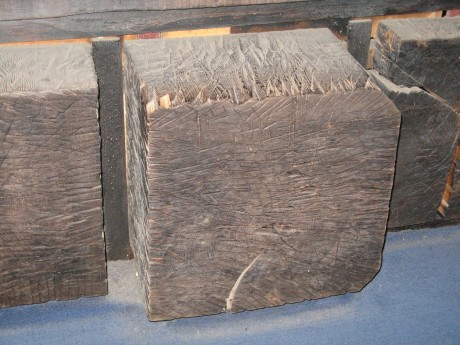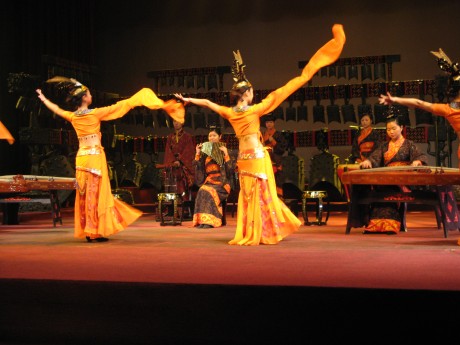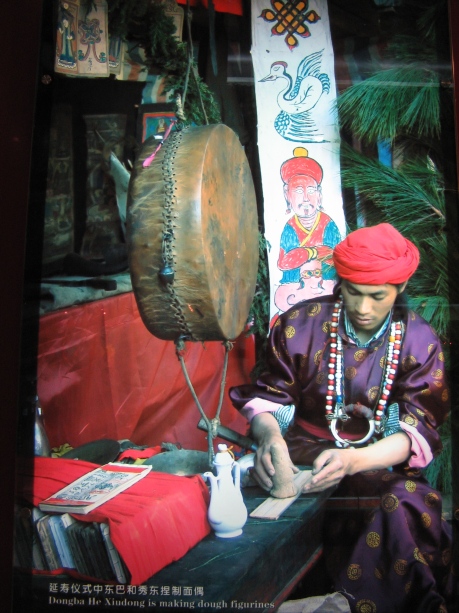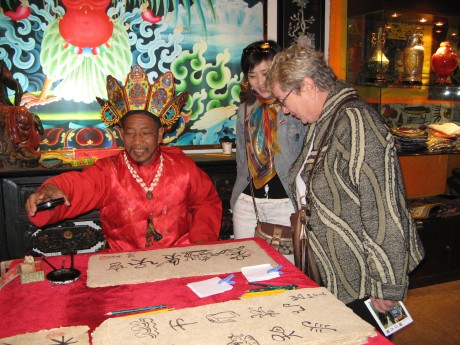Correction. I’m working from my hand written journal from 2006, often writing during lunch or on the bus, or catching up at the end of the day. I identified a stop at a tourist center with pit toilets as the “new” Wuhan City. It was not.
Our visit to the farmer was from the long bus ride on the way to this 350,000 year old Wuhan City. More than eight million people live in Wuhan, about the population of our state of Delaware. We see western imports, Mc Donalds, KFC, Michelin Tires. People are more affluent, they drive Fords. This is considered one of the furnace cities, one of the hottest cities in China and very humid as well. Vicki tells us there is corruption here, the roads have very poor quality cement. People sell knockoff designer goods even though they face big fines. We spend the night here and catch the Wuhan History Museum and a dinner show.
In 1978, an ancient tomb was found here from 430 BC. The remains of the Marquis Teng.

Huge timbers from the tomb were still in incredibly good shape. Inside with the Marquis was the remains of 13 concubines and an array of musical instruments, zithers, bells with two tones, bronze utensils, flutes, drums and whistles.

The bells are set up to play in a structure.

The evening show featured a concert on a replica of those bells on which they could play Ode to Joy by Beethoven. Pretty sophisticated bells.
In the morning we get to the airport and find out we are overweight. Vicky bribes the officials and they let us on. She warns us that we will pass through one airport on this trip where bribery won’t work. I report my damaged suitcase and the officials there will not fill out the form because when the y asked the color of my suitcase I told them beige plaid. They do not have the color beige nor plaid on their form.
The long flight to Jiliang (lee-john) through several time zones puts us in the city at 10 pm. The hotel held the buffet dinner for us. We taste fried milk and black rice, a wonderful sweet desert.

Our hotel is right in the middle of “Old Town” a UNESCO site. Hotel windows have no glass, the beds are hard wood with light padding and warm woolen covers. You can hear people in the next room talking in a normal tone of voice. We are tired and sleep soundly in the fresh mountain air. The next morning we wake up to this view of the town across the moat. Lijiang is only 250 miles from the Tibetan border and is populated by the minoirty Naxi, (Nah-shee) people.

After breakfast we visit the Naxi Dongba Museum. The people here are known for their textiles. Their language was originally pictorial and an English Anthropologist saved their language from extinction. The Naxi people are known for their ability to stick their hands in the fire and in boiling oil. (Not a demonstration we witnessed.) Apparently, an ability similar to fire walkers.

A tattooed Naxi woman weaving, a picture from a picture in the museum. We enjoy the history but prefer to get out and look around town.

This young vendor is making dough figures and stamps for sealing letters with wax.

Michal and I find a talented calligrapher and Vicky instructs him what she wants written on her piece of art. We will stay in Lijiang for a week and travel to nearby Naxi villages.
Our visit to the farmer was from the long bus ride on the way to this 350,000 year old Wuhan City. More than eight million people live in Wuhan, about the population of our state of Delaware. We see western imports, Mc Donalds, KFC, Michelin Tires. People are more affluent, they drive Fords. This is considered one of the furnace cities, one of the hottest cities in China and very humid as well. Vicki tells us there is corruption here, the roads have very poor quality cement. People sell knockoff designer goods even though they face big fines. We spend the night here and catch the Wuhan History Museum and a dinner show.

In 1978, an ancient tomb was found here from 430 BC. The remains of the Marquis Teng.

Huge timbers from the tomb were still in incredibly good shape. Inside with the Marquis was the remains of 13 concubines and an array of musical instruments, zithers, bells with two tones, bronze utensils, flutes, drums and whistles.

The bells are set up to play in a structure.

The evening show featured a concert on a replica of those bells on which they could play Ode to Joy by Beethoven. Pretty sophisticated bells.
In the morning we get to the airport and find out we are overweight. Vicky bribes the officials and they let us on. She warns us that we will pass through one airport on this trip where bribery won’t work. I report my damaged suitcase and the officials there will not fill out the form because when the y asked the color of my suitcase I told them beige plaid. They do not have the color beige nor plaid on their form.
The long flight to Jiliang (lee-john) through several time zones puts us in the city at 10 pm. The hotel held the buffet dinner for us. We taste fried milk and black rice, a wonderful sweet desert.

Our hotel is right in the middle of “Old Town” a UNESCO site. Hotel windows have no glass, the beds are hard wood with light padding and warm woolen covers. You can hear people in the next room talking in a normal tone of voice. We are tired and sleep soundly in the fresh mountain air. The next morning we wake up to this view of the town across the moat. Lijiang is only 250 miles from the Tibetan border and is populated by the minoirty Naxi, (Nah-shee) people.

After breakfast we visit the Naxi Dongba Museum. The people here are known for their textiles. Their language was originally pictorial and an English Anthropologist saved their language from extinction. The Naxi people are known for their ability to stick their hands in the fire and in boiling oil. (Not a demonstration we witnessed.) Apparently, an ability similar to fire walkers.

A tattooed Naxi woman weaving, a picture from a picture in the museum. We enjoy the history but prefer to get out and look around town.

This young vendor is making dough figures and stamps for sealing letters with wax.

Michal and I find a talented calligrapher and Vicky instructs him what she wants written on her piece of art. We will stay in Lijiang for a week and travel to nearby Naxi villages.
No comments:
Post a Comment